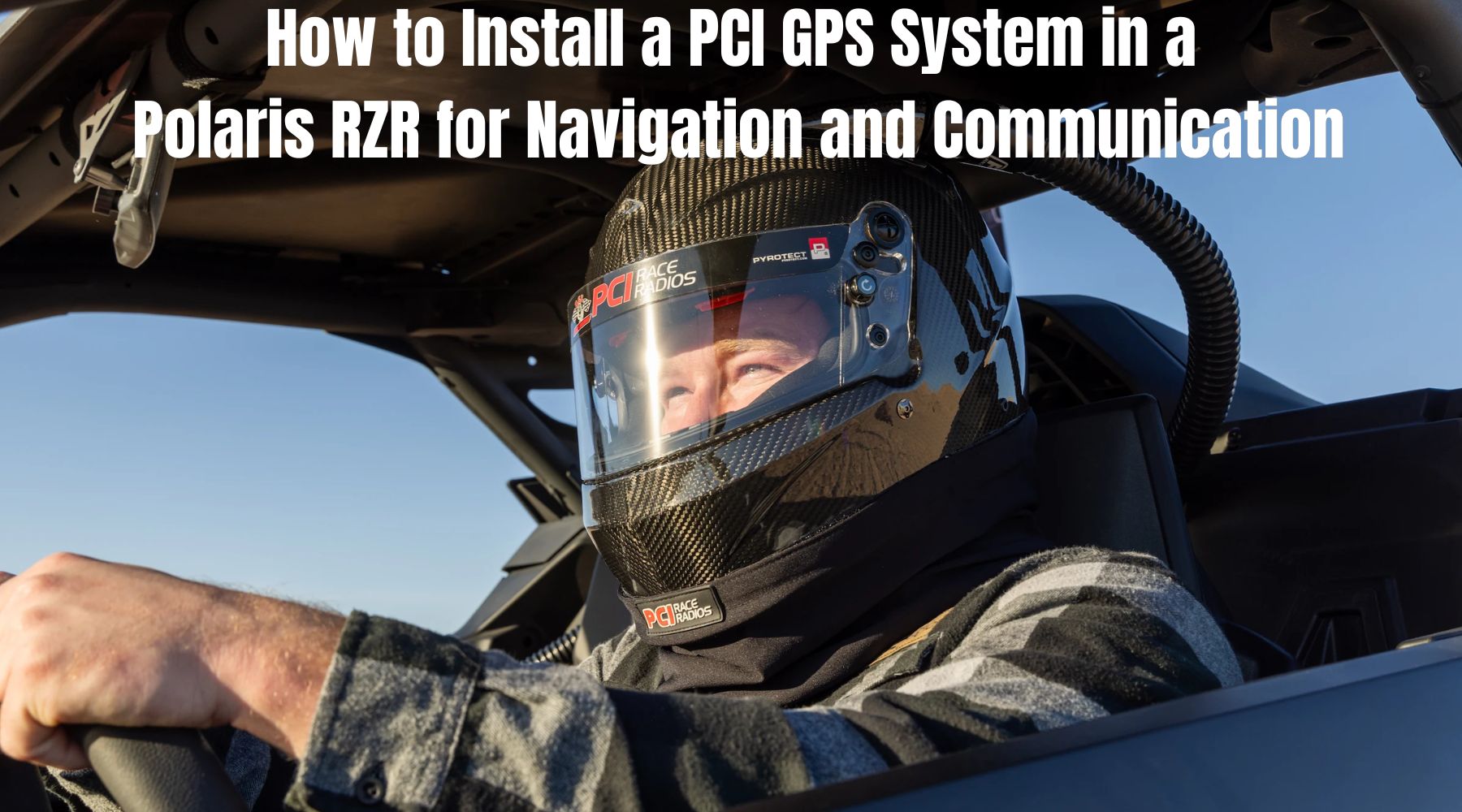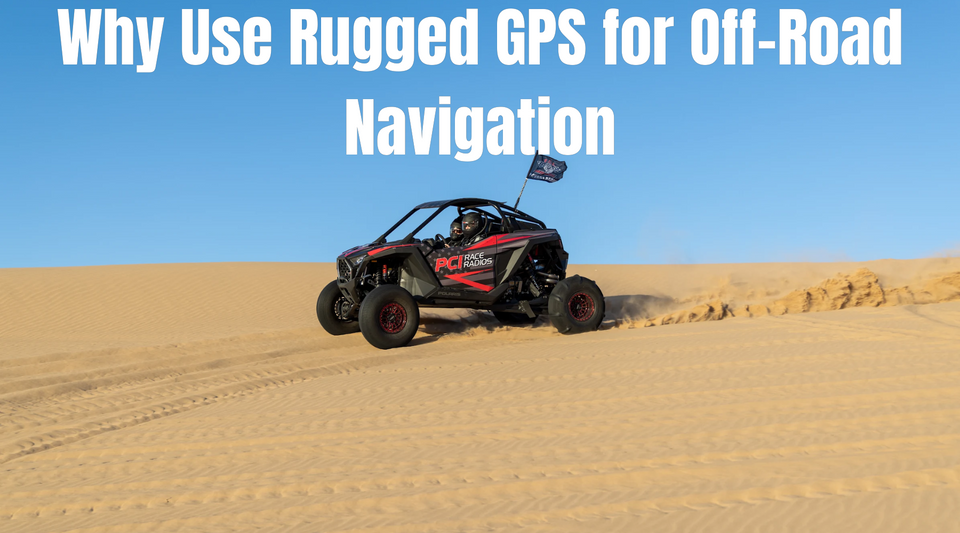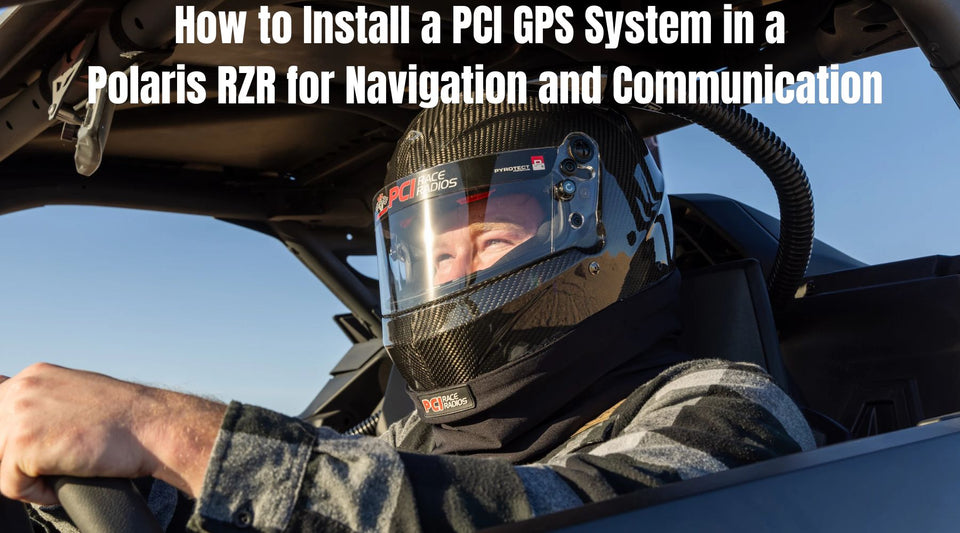
How to Install a PCI GPS System in a Polaris RZR for Navigation and Communication
Off-road riders and racers need dependable navigation with clear comms. This step-by-step PCI guide walks through how to install GPS in a Polaris RZR, clean mounting options, and intercom/radio integration for trail-proven performance across the USA. Based in Cypress, CA, PCI backs the process with purpose-built brackets, wiring accessories, and a dedicated Help Center.
Why install PCI GPS in a Polaris RZR?
A dedicated off-road GPS paired with PCI communications delivers precise trail mapping, reliable course tracking, and team coordination—far beyond mobile apps. With RZR‑specific mounts, harness-friendly layouts, and PCI support resources, most DIY UTV owners can complete the install confidently.
Trail mapping and safety
-
Load trails, racecourses, and waypoints for confident desert, forest, and mountain navigation.
-
Maintain accurate headings when dust, darkness, or split trails make decisions tricky.
Integrated communication and tracking
-
Share callouts, hazards, and pit instructions over intercom and radio while referencing the same GPS screen.
-
Reduce confusion and time loss with synchronized navigation and comms in technical sections and recoveries.
Pre‑installation checklist
For model dimensions, dash clearances, and electrical specs, review the Polaris RZR Off‑Road Specs.
Tools needed
-
Screwdrivers (Phillips/flat), Torx/Allen keys
-
Ratchet/socket set, torque specs as needed
-
Plastic trim tools for dash plastics
-
Drill and step bit (if adding a switch/custom routing)
-
Wire crimper/stripper, heat shrink, electrical tape
-
Zip ties, cable loom/sleeving, adhesive mounts
-
Multimeter to verify switched power and continuity
Recommended PCI parts and kits
-
For a factory-style dash fit, consider the RZR Pro Series 7-inch GPS Dash Bracket.
-
Prefer adjustability? Mount the screen on a RZR XP1000 Grab Bar 7-inch GPS Bracket.
-
For quick angle changes, the RZR Pro Billet Grab Bar GPS Mount works great with harnesses.
-
Explore Polaris RZR GPS mounts and kits to choose the right bracket and screen size.
-
For firmware versions and wiring references, check the PCI Help Center.
-
Update maps and race files from PCI’s Free GPS downloads.
Step‑by‑step installation
Mounting the GPS bracket
-
Choose the location and bracket
-
Dash mount (Pro XP/Pro): The PCI RZR Pro Series 7" dash bracket gives a factory-style look with minimal glare.
-
Grab bar mount (XP 1000/Pro): The RZR Grab Bar 7" bracket or Billet Grab Bar Mount offers adjustable sightlines and quick removal.
-
Ride Command note: The PCI dash bracket is for vehicles without Ride Command. If equipped, use a grab bar solution or an alternate compatible mount.
-
Dry fit and sightline
-
Belt in the driver seat; verify screen angle, button access, and glovebox/switch clearance.
-
Confirm harness and passenger knees won’t impact the GPS on rough terrain.
-
Secure hardware
-
Install with supplied hardware and proper torque.
-
Add a thin anti‑vibration pad if desired for washboard or race use.
Routing power and signal cables
-
Power source
-
Use a fused, switched 12V circuit or an accessory fuse block/relay to prevent battery drain.
-
Suggested wire gauge: 16 AWG for short GPS runs; upsize for longer runs or combined loads.
-
Fuse guideline: 3–5A for most GPS units (follow device specifications).
-
Grounding
-
Use a clean chassis ground or ground bus on the accessory fuse block; avoid sharing grounds with light bars or fans.
-
Antennas and signal
-
If using an external heading sensor (e.g., Point‑1), mount with clear sky view and route cable away from RF sources.
-
Keep radio coax separated from GPS power/signal and high‑current power runs to minimize noise.
-
Cable management
-
Follow factory looms and frame edges; avoid pinch points, seat tracks, hot surfaces, and steering linkages.
-
Use loom/sleeve and spaced zip ties; don’t overtighten. Leave small service loops at the GPS, intercom, and radio.
For additional visual guidance on GPS mounting, harness routing, and connector handling, see this UTV Driver install article
Connecting to PCI communication systems

Intercom and radio integration
-
Choose a complete kit (e.g., 696 Plus/BT or STX intercom with M1/G1 radio) with PTTs, coax, antenna, and mounts.
-
Mount the intercom within easy reach; route helmet leads along the tunnel or seat bases and secure them cleanly with strain relief. Add compatible helmet kits with audio so mic and speakers match the intercom and radio.
-
Install driver PTT on the steering wheel and co‑driver PTT on the grab bar with strain relief.
-
Even with Bluetooth intercoms, retain the 3.5 mm music/phone lead so passengers can plug in instantly.
Shared battery or fuse block options
-
Best practice: A relay‑triggered accessory fuse block for GPS, intercom, radio, and RaceAir.
-
Separation: Keep radio coax away from light bar wiring; maintain an adequate antenna ground plane and clear roofline.
Ride Command caveats and workarounds
-
Dash real estate: If Ride Command occupies the dash, use a grab bar mount.
-
Power planning: Use an accessory fuse block rather than tapping Ride Command circuits to avoid noise/faults.
-
Audio routing: If feeding Ride Command audio into the intercom, use isolated line‑level adapters and maintain clean grounds.
-
For OEM specs, display features, and map update procedures, see the Polaris RZR Ride Command Owner’s Manual.
Testing and troubleshooting
GPS lock and calibration
-
First boot: Move outdoors with clear sky; allow several minutes for initial satellite lock.
-
Orientation: Set course‑up or north‑up; verify speed, heading, and map display.
-
SD updates: Apply firmware via a blank SD card only; keep mapping cards separate to avoid conflicts.
Audio system connectivity check
-
With engine running, listen for alternator whine; fix by improving grounds, separating power from audio/coax, or adding filters.
-
Verify VOX/PTT for all helmets and test radio transmit/receive range and antenna placement.
-
After verifying VOX/PTT and radio range, upgrade or replace worn mic/speakers with helmet kits with audio for clearer comms at higher RPM and in dusty conditions.
Common issues and quick fixes
-
Reboot loop after update: Reformat SD (FAT32), copy only the correct unzipped update files, retry; confirm version compatibility in the Help Center.
-
Heading drift: Verify external sensor configuration and perform model‑specific calibration.
-
RF‑induced audio cutouts: Reroute coax away from power harnesses; check the antenna ground plane and tighten connectors.
-
Parasitic drain: Ensure GPS is on switched power or relay; confirm no accessory stays live with the key off.
Maintenance tips
Securing connectors
-
Re‑check zip ties/mounts after the first ride; vibration can loosen hardware.
-
Inspect antenna and GPS/intercom connectors quarterly, especially after dust or mud.
Post‑ride cleanup practices
-
Avoid direct pressure washing on connectors; wipe the screen with a microfiber cloth.
-
Back up ride logs/waypoints and periodically update maps/firmware via PCI’s Free GPS downloads and Help Center guides.
Many universal install guides cover comms wiring and antenna placemen, but skip RZR‑specific GPS bracket fitment, Garmin adapter notes, and Ride Command workarounds. This guide adds exact PCI bracket options, fuse sizing, and wire gauge guidance, RF noise separation, and a consolidated troubleshooting list so installs are cleaner and more reliable for RZR Pro/XP platforms.
FAQs About Installing PCI GPS in a Polaris RZR
Can I install a PCI GPS system in my Polaris RZR myself?
Yes, most DIY UTV owners can install a PCI GPS system with basic tools and wiring knowledge. This guide covers step-by-step installation to make the process easier.
Do I need a PCI helmet kit for communications?
If you want to integrate intercom and radio systems, a PCI helmet kit ensures clear audio and proper mic/speaker wiring. It’s highly recommended for group rides and races.
What’s the best power connection method?
You can connect through a shared battery or fuse block. A fuse block setup is safer and prevents overloading your RZR’s main battery lines.
Does PCI GPS work with Ride Command?
Yes, PCI GPS units can work alongside Polaris Ride Command, but PCI GPS systems are more advanced for racing and off-road navigation compared to stock Ride Command features.
Call to action
Build the kit, mount the GPS, and hit the trail with confidence. Shop RZR GPS brackets and complete comms packages, or get U.S.‑based support for fitment and wiring:




